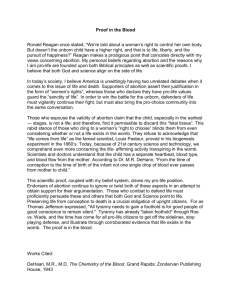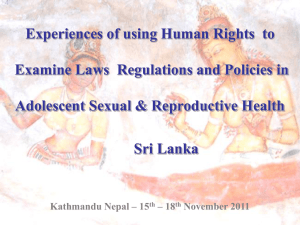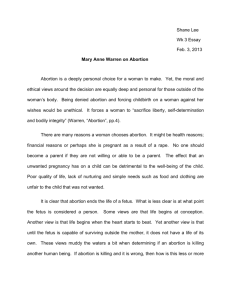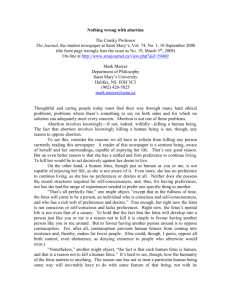What I want to write for my thesis is that I want to see the abortion
advertisement
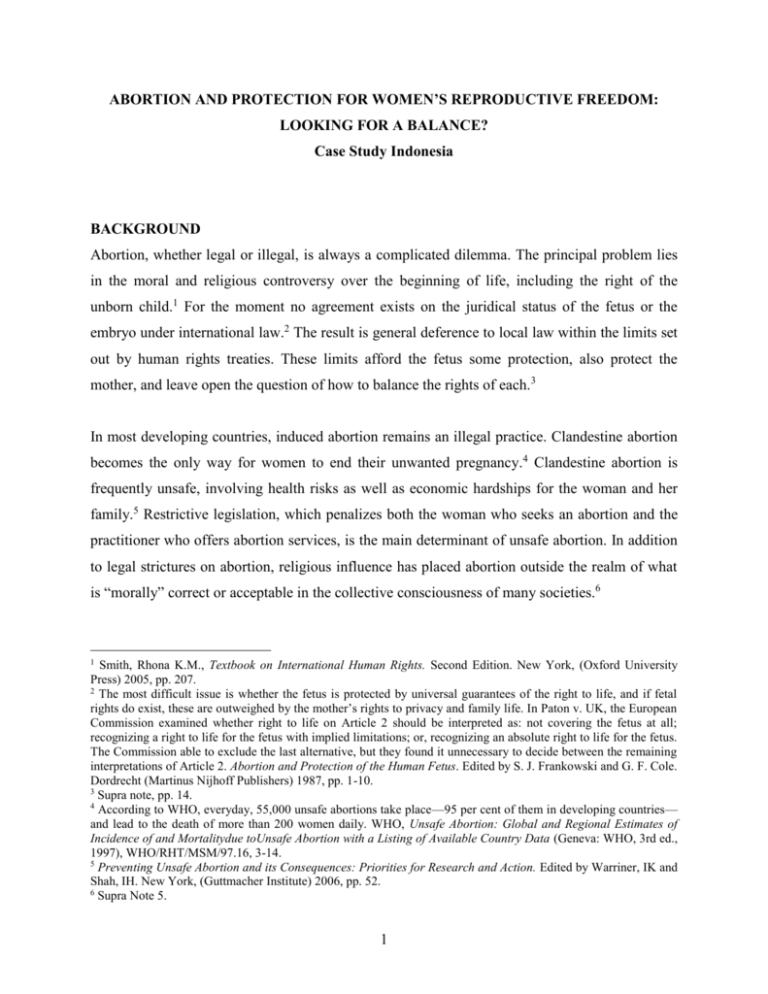
ABORTION AND PROTECTION FOR WOMEN’S REPRODUCTIVE FREEDOM: LOOKING FOR A BALANCE? Case Study Indonesia BACKGROUND Abortion, whether legal or illegal, is always a complicated dilemma. The principal problem lies in the moral and religious controversy over the beginning of life, including the right of the unborn child.1 For the moment no agreement exists on the juridical status of the fetus or the embryo under international law.2 The result is general deference to local law within the limits set out by human rights treaties. These limits afford the fetus some protection, also protect the mother, and leave open the question of how to balance the rights of each.3 In most developing countries, induced abortion remains an illegal practice. Clandestine abortion becomes the only way for women to end their unwanted pregnancy.4 Clandestine abortion is frequently unsafe, involving health risks as well as economic hardships for the woman and her family.5 Restrictive legislation, which penalizes both the woman who seeks an abortion and the practitioner who offers abortion services, is the main determinant of unsafe abortion. In addition to legal strictures on abortion, religious influence has placed abortion outside the realm of what is “morally” correct or acceptable in the collective consciousness of many societies.6 1 Smith, Rhona K.M., Textbook on International Human Rights. Second Edition. New York, (Oxford University Press) 2005, pp. 207. 2 The most difficult issue is whether the fetus is protected by universal guarantees of the right to life, and if fetal rights do exist, these are outweighed by the mother’s rights to privacy and family life. In Paton v. UK, the European Commission examined whether right to life on Article 2 should be interpreted as: not covering the fetus at all; recognizing a right to life for the fetus with implied limitations; or, recognizing an absolute right to life for the fetus. The Commission able to exclude the last alternative, but they found it unnecessary to decide between the remaining interpretations of Article 2. Abortion and Protection of the Human Fetus. Edited by S. J. Frankowski and G. F. Cole. Dordrecht (Martinus Nijhoff Publishers) 1987, pp. 1-10. 3 Supra note, pp. 14. 4 According to WHO, everyday, 55,000 unsafe abortions take place—95 per cent of them in developing countries— and lead to the death of more than 200 women daily. WHO, Unsafe Abortion: Global and Regional Estimates of Incidence of and Mortalitydue toUnsafe Abortion with a Listing of Available Country Data (Geneva: WHO, 3rd ed., 1997), WHO/RHT/MSM/97.16, 3-14. 5 Preventing Unsafe Abortion and its Consequences: Priorities for Research and Action. Edited by Warriner, IK and Shah, IH. New York, (Guttmacher Institute) 2006, pp. 52. 6 Supra Note 5. 1 PROBLEM STATEMENT Abortion is illegal in Indonesia and categorized as a criminal behavior (“Abortus Provocatus Criminalis”).7 However, abortion is still allowed in certain condition as stated in Law of Health No. 23/1992 article 15 paragraph (1) “in case of emergency, and with the purpose of saving the life of a pregnant woman and or her fetus [emphasis added], it is permissible to carry out certain medical procedures”.8 Vague legal and illegal dimension on abortion status makes such conflicting interpretation of existing law that difficult for the average citizen to understand where the protection lies. Every year estimated 2 million women choose to end their unwanted pregnancy through an abortion in Indonesia. This situation raised awareness from the health practitioners and women’s organizations and push government to revise the existing law. Through the amendment they hope government can give more attention to women’s rights for reproductive health. The public discourse has been started from 2000, but the new draft of law has not implemented yet. With the above concern, my research questions will be: 1. Is there any universal protection for the right to life of unborn child? And if there is any, what is the justification for women to perform abortion? It will address the competing claims that international human rights standards hold on both for the unborn child’s right to life and pregnant women’ rights for their reproductive freedom. 2. To see how abortion is regulated in Indonesia. How national legal system in Indonesia address abortion practice, how it confirms with international human rights instrument and also the cultural, religious and proper norms in the society, and where the law stand between the fetus right to life and women’s right for reproductive freedom. Article 346 of the Penal Code of Indonesia provides that ”Any woman who deliberate intends, causes or lets another cause the drifting off to death of the fruit of her womb, shall be punished by a maximum imprisonment of four years.” No exceptions are provided for. Benninger-Budel, Carin and Anne-Laurence Lacroix, Violence Against Women: A Report. World Organization Against Torture (OMCT), 1999, pp. 235. 8 Law of Health No. 23/1992 was created in order to give clear guidance in what situation abortion is allowed. But on the explanation of Article 15(1) further stated: ’Medical procedures in the form of “abortion”, for any reason, are forbidden because they violate legal norms, religious norms, ethical norms, and norms of propriety [emphasis added]. Nevertheless, in case of emergency, and with the purpose of saving the life of a pregnant woman and or the fetus in her womb, it is permissible to carry out certain medical procedures’. The contradictive content of the Article 15(1) and its expalantion create ambiguity in the abortion policy, and until now Government Regulation that supposed to give further implementation guidance for this law is never created. 7 2 SCOPE AND LIMITATION OF THESIS Within UN the issue of women’s access to legal abortion and counseling as well as to service has been of major concern of Committee on the Elimination of Discrimination against Women (CEDAW). But CEDAW has not yet mentioned what specific requirements the Women’s Convention may impose on the substance of domestic abortion laws.9 Some recommendations suggest that states should take measures to prevent women seek unsafe medical procedures such as illegal abortion10 and should consider decriminalization of abortion in their national legal system.11 Different standard that states put to restrict abortion and the general natures of the relevant human rights provisions on reproductive freedom, that open the opportunity to approach the abortion issue by means of interpretation, will challenge the legal system in Indonesia in addressing this issue. However, all of the conflicting interpretation exist should be confirmed within the limit of generally accepted principles of law on the interpretation of treaties article 31 paragraph (1) of the Vienna Convention on the Law of the Treaties, that stated: “A treaty shall be interpreted in good faith in accordance with the ordinary meaning to be given to the terms of the treaty in their context and in the light of its object and purpose”.12 PREVIOUS STUDIES Several books and articles have been written on the issue of abortion and protection of the fetus, and how it relate to women’s reproductive freedom, which more detail in this research will be applied to special case study about abortion practice and family planning in Indonesia.13 METHODOLOGY AND SOURCES I will use qualitative method in approaching my research. Problem background will be described through a descriptive method. Further, content analysis of international human rights instruments that relevant for my topic is necessarily aimed to get the general meaning, from all the source of 9 Eriksson, Maja Kirilova. Reproductive Freedom: In the Context of International Human Rights and Humanitarian Law. The Hague (Martinus Nijhoff Publishers), 2000, pp. 301-302. 10 CEDAW, G.A. Res. 34/180, UN GAOR, 34th Sess., Supp.No.46, at 193, UN Doc.A/34/46 (1979), para. 24 (m). 11 CEDAW Committee, General Recommendation No. 24, Women and Health, UN Doc. No. A/54/38/Rev.1 (1999), para. 31(c). 12 Supra note. 9, pp. 304. 13 Supra note 2, 5 and 9. 3 law used here, that in the end can be used in particular reflecting the complexity of this abortion matter that exist in Indonesia. Sources of law will be the relevant international human rights instruments, that almost all has been ratified and adopted it in national legal system in Indonesia.14 International human rights sources in this case will be ICCPR, CEDAW and CRC. Recommendations from CEDAW committee, ICPD in Cairo and Women’s conference in Beijing will be a very important source, though they are not binding instruments. Jurisprudence from European Court of Human Rights will be included in particular on state’s obligation to protect life of fetus in respect termination of pregnancies.15 All these international documents will be useful in analyze abortion problems in Indonesia and set a framework for the national legislation in ensure human rights protection within its territory. HYPOTHESIS AND EXPECTED RESULT My research will try to examine the abortion practice and right to life of unborn child according to national law in Indonesia. To deal with fetus right means that I have to look other right which is women’s right for reproductive freedom. Not trying to oversimplify this problem, but the recognition of one’s right here, might close to the violation of other. The study will be conducted according to hypothesis: 1. There is no clear regulation of abortion in Indonesia, that the vagueness of this law fail to give certain protection for unborn child, and at the same time risk the violation for women’s rights in certain extent; 2. Abortion is not appropriate morally according to culture, religious and proper norms in Indonesia. Make no limitation in abortion practice might be too controversial in the society; however there is no exception for government in providing protection for women’s rights. I hope by the end of my research I could find the justification exist in approaching the conflicting rights that exist between right to life of the unborn child and women’s right for reproductive freedom in case of abortion regulation in Indonesia. 14 Relevant international instruments that Indonesia has ratified and adopted in our national legal systems: International Civil and Political Rights (ICCPR) with Law no. 12/2005; CEDAW with Law No. 7/1984; and also Covenant on the Rights of Child through Law No. 36/1990. 15 Maybe will be focus on court judgment in case Vo v. France (Case No. 53924/00). 4


